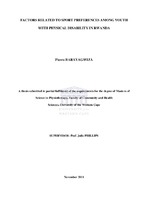| dc.description.abstract | Sport participation can play a vital role in enhancing life of youth with physical disabilities. This is because of the rehabilitative influence sport can have not only on the physical body but also on rehabilitating people with disability into society. A successful sport programme in which the youth with disabilities are involved should possibly respect youth‟s wishes regarding the preference of the sport. The Review of the literature revealed that little has been documented about the status of disability sport in developing countries. Given the psychosocial and physiological benefits of sport in everyone‟s life, including those with physical disabilities, there is a need for a study to document the status of sport of this sub-population in Rwanda. This study, therefore, aimed to identify the factors associated with sport preferences among youth with physical disabilities in Rwanda. A sequential mixed model design was used to collect data, specifically the sequential explanatory strategy. Data was collected by means of a self-administered questionnaire and a total number of 204 participants voluntarily answered the questionnaire. Semi-structured interviews were conducted among four (4) NPC staff to collect data regarding the challenges experienced by youth with physical disabilities with regard to sport preferences. The Statistical Packages for Social Sciences (SPSS) version 19 was used for data capturing and data analysis. Descriptive statistics were employed to summarize demographic information as means, standard deviation, frequencies and percentages. Inferential statistics (chi-square and independent samples t-tests) were used to test the associations between different categorical variables (p<0.05). For the qualitative data, audiotaped interviews were transcribed and translated from Kinyarwanda into English, and the expressed ideas were coded and reduced into subthemes and categories. Thematic analysis was then done under the generated sub-themes. Permission to conduct this study was obtained from the concerned authorities. Ethical issues pertaining to informed consent, anonymity, confidentiality and the right to withdraw from the study were respected in this current study. The results of the current study revealed that the top five sports played by youth with physical disabilities were sit ball, sitting volleyball, volleyball, table tennis and wheelchair basketball. It also showed that youth with physical disabilities were committed to and enjoyed their sport experience. Additionally, they have had strong feelings about their physical abilities. Discouragingly, the results indicated that the youth with physical disabilities have had low perception that their parents were supportive of their participation in sport. The findings further showed that age, gender, use or non-use of mobility aids, and type of impairment influenced the choice of sport. However, there was no statistically significant association between demographic characteristics and some sports codes played in Rwanda. During the semi-structured interviews, the participants reported the challenges experienced by youth with physical disabilities with regard to sport preferences including physical factors (lack of accessible facilities, uneven playgrounds, transport to and from sport fields, resources and limited sporting codes available), social factors (lack of parental support and models) and financial factors (inhibit the implementation of many sport codes, high cost of adaptive equipment) which influence the youth with physical disabilities to choose a sport with sufficient facilities even if they do not like it. Factors that emerged as facilitators for sport preferences include: sport availability, perceived ability to handle a sport, friendship, facilities, improved individual competences, independence in mobility gained, and to take part in international tournaments. Based on the results of this study, and the role of sport in preventing many chronic diseases, it is apparent that there is a need to widen the spectrum of sport opportunities and to create awareness among youth with physical disabilities. Furthermore, there is a need to provide social and a local barrier-free inclusion of various stakeholders in recommending and designing sport programmes for the youth with disabilities. | en_US |

